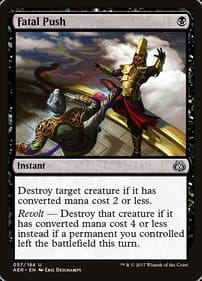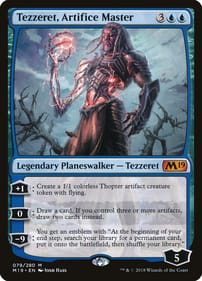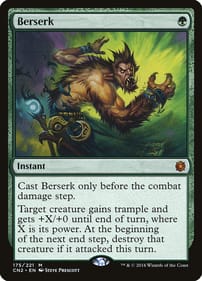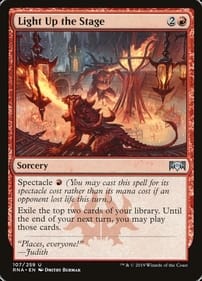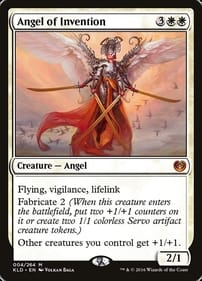Introduction
Hey there,
if you made it to this article, you have probably already heard about The Mythic Society’s monthly Set Roulette Tournament. If you are not familiar with the rules, you find everything you need to know on the official tournament page.
You won’t, however, find the unofficial rules to the monthly Set Roulette there (which I didn’t not totally make up on the fly):
- Talk & think a lot about the monthly Set Roulette.
- Talk & think A LOT about the monthly Set Roulette.
- Brew a lot & Play a lot
- If you are new to the monthly Set Roulette, you will find friendly opponents in The Mythic Society’s Discord
Why should you play Set Roulette?
If you like brewing whacky decks and don’t fear unknown environments, Set Roulette is the place to be: There is no set meta, no set-in-stone heuristics and no data to show what’s performing well and what isn’t.
If you like to take a break from repetitive game patterns of Standard, Modern or Historic, Set Roulette will be a unique experience and there will be very many unexpected cards and interactions (for a week). In my opinion, Set Roulette really plays into the strengths of the game framework that is Magic: The Gathering and definitely sparked my desire to brew and play again every month.
There’s a lot more to like about the format which I won’t be able to put into words today.Let’s put it like this:
What I enjoy the most is finding the most broken things and combos Magic: The Gathering has to offer which most of the time are not feasible to use in competitive formats and environments the big tournaments are usually held in.
Speaking of broken things. Exhibit A:
You will find the answer on the bottom of the page.
The Sets of Eldrazi Winter: Pandemic Edition
Every month, six sets are randomly drawn out of all sets printed before War of the Sparks. One “core” set including Master’s Edition on Magic Online, two “big” sets and three “small” sets. Without further ado, let’s look at the sets in chronological order:
Rivals of Ixalan (2018) - All about tribes (no rebels)

The Ixalan block introduced Dinosaurs and Pirates to the creature mix, the former causing many old cards to be errata’ed. Somewhat more importantly , the Ixalan block retroactively turned all Planeswalkers into Legendary Planeswalkers which simplified a lot of interactions in eternal formats.
Due to the heavy tribal theme (Dinosaurs, Merfolk, Vampires, Pirates) of the block it doesn’t bring a lot to the table for this iteration of Set Roulette.
Keywords/Abilities
Enrage: Some Dinosaurs have triggered abilities when dealt damage.
Ascend: Cards get stronger once you hit 10 permanents (The City’s Blessing) on the board.
Raid: ETB-abilities that only trigger if you attacked with a creature this turn.
Explore: ETB-ability printed on creatures. If your top card is a land: Draw it. Otherwise, put a +1/+1 counter on that creature and either put it back or into your graveyard.
Notable/Unique cards
Ravenous Chupacabra, Ghalta, Primal Hunger, The Immortal Sun and Zacarma, Primal Calamity.
Set Roulette Power Rating
2/10.
Between all the tribal synergies, the best cards just don’t interact all that well with what other sets have to offer.
Oath of the Gatewatch (2016) - The Eldaziphant in the room

The story of Oath of the Gatewatch (OGW) was yet another tale about the adventures of the Gatewatch (Gideon, Jace, Liliana, Chandra, Nissa, Ajani, Teferi and Kaya) and their struggles against the evil of the Planes (Eldrazis or Nicol Bolas).
The addition of the colorless mana symbol changed the card design of the lands from then on out.
OGW also completed the enemy-colored manland cycle with Wandering Fumerole, Hissing Quagmire and Needle Spires.
If I’m not mistaken, the months that followed the release of OGW were considered as “Eldrazi Winter”, mainly due to the brokenness of the Modern format highlighted at Pro Tour Atlanta 2016 where six of the eight Top 8 competitors registered Thought-Knot Seers and friends in the Modern portion. (Some of The Mythic Society’s team members might remember that tournament fondly).
The result of Eldrazi Winter was a ban of Eye of Ugin in Modern which did a lot for the format-diversity of Modern. The powerful colorless Eldrazi creatures are still played on and off Modern, Legacy and even Vintage today.
Keywords/Abilities
Colorless Mana Symbol: In addition to the WURBG-color requirements, casting and activation costs could now explicitly require you to pay colorless mana. Wastes was added as an additional Basic Land which only produces colorless mana.
Surge: You can cast cards for their Surge-costs when a spell was played by you or a teammate this turn. Cards cast for their Surge-costs receive a boost.
Support X: Put a +1/+1 counter on each of up to X creatures.
Cohort: Some of the Allies in the set have activated abilities that require you to tap an additional Ally to activate.
Notable/Unique cards
Thought-Knot Seer, Reality Smasher, Eldrazi Displacer, Kozilek, the Great Distortion, Reflector Mage.
Set Roulette Power Rating
9/10.
The only thing missing are powerful dual lands, but other than that, there’s a lot of strong and unique creatures that will show up a lot on Sunday. (The unofficial line seems to be “over/under 11.5 Thought-Knot Seer in the Top 8”.)
Thought-Knot Seer will be the most registered creature by a small margin (Reality Smasher being a close second).
Master’s Edition IV (2011)

Master’s Edition IV (ME4) was exclusively designed for MtGO and included some of the most powerful cards ever printed:
The original dual lands were put besides cards like Sol Ring, Mana Vault, Dark Ritual, Swords to Plowshares, Fastbond, and other iconic cards like Demonic Tutor or even Sengir Vampire.
There actually was a short discussion on the discord server whether or not ME4 is too strong of a set to be included in the Set Roulette, but following the philosophy of “everything goes and no bans unless the card is bugged”, we will see where this will take us. (Spoiler alert: broken decks)
I will skip the keywords/abilities part for this set because the design-focus was to create a fun limited environment with powerful old cards while also adding Duals and other Legacy staples to the MtGO cardpool.
Notable/Unique cards
Mana Vault, Sol Ring, Fastbond, Dark Ritual, Channel, Dual Lands, Strip Mine, Library of Alexandria, Mishra’s Workshop, Demonic Tutor, Wheel of Fortune. Balance, Stasis, Time Vault.
Set Roulette Power Rating
10/10.
You can see by the sheer number of cards in the list how broken this set is for Set Roulette. Some cards that didn’t make the list could have easily been on the list for most of the other sets.
Basically every deck will at the very least profit from the Duals as it makes your mana just so much smoother and luckily, acquiring Duals on MtGO is not nearly as costly as getting them IRL.
If you scroll down a bit more, most of the abovementioned cards will find their way into one or more of the brews and cards like Fastbond and Sol Ring are clear build-arounds that will guide a lot of the deck design decisions for your own deck, either because you want to play with them or because you want to have answers for your opponent’s copies.
Ravnica: City of Guilds (2005) - Dredge me if you can

Magic players really like multicolor cards (or gold cards as seen in Apocalypse) so it’s no surprise that Ravnica: City of Guilds (RAV) was a successful set at the time of the release. RAV also first introduced the Shock Lands which until today are a huge factor in both Modern and Pioneer. The Dredge ability sparked its own category of decks.
Cards and abilities are tied to their respective two-color guilds which were continually introduced over the sets. RAV introduced Selesnya (White-Green), Boros (White-Red), Dimir (Blue-Black) and Golgari (Black-Green).
Keywords/Abilities
Hybrid Mana: The cost of some abilities could include one of the hybrid mana symbols which can be paid with either the one or the other color of mana.
Dredge X: You can put a card with Dredge that’s in your graveyard into your hand by milling X cards instead of drawing a card.
Convoke: You can pay for the mana cost of cards with Convoke by tapping untapped creatures you control.
Transmute: You can use the Transmute ability at sorcery speed and discard the card to tutor for a card with the same mana cost as the discarded card.
Radiance: Spells and effects with Radiance take effect on all permanents sharing a color with the target.
Notable/Unique cards
Life from the Loam, Lightning Helix, Chord of Calling, Dark Confidant, Doubling Season, Temple Garden, Sacred Foundry, Watery Grave, Overgrown Tomb.
Set Roulette Power Rating
7/10.
Ravnica brings a lot of interesting tools and role-players to the pool. If you like using your graveyard as a ressource, large parts of the Modern/Vintage Dredge deck were printed in RAV.
With a lot of utility lands (read: Strip Mine) in the other sets, Life From the Loam will definitely be played in a lot of decks.
Apocalypse (2001) - Who needs flavor text anyways?

Apocalypse (APC) was the last set of the Invasion block and featured multicolored cards with a focus on the five enemy-color pairs. I don’t have a lot to say about the set’s flavor because most of the themes and mechanics are tied to the rest of the Invasion block.
Fun fact: I didn’t see any APC card without any rules text, so it literally had no vanilla creatures.
Keywords/Abilities
Split cards: Cards that have two different modes. You can choose one of the modes when casting the card.
Kicker: You can pay additional mana to unlock more modes of cards.
Notable/Unique cards
Pernicious Deed, Vindicate, Fire//Ice, Battlefield Forge, Caves of Koilos, Llanowar Wastes, Shivan Reef, Yavimaya Coast.
Set Roulette Power Rating
2/10.
While there are some cute and cool cards that see occasional play in Cube Draft, the only card cycle that really adds to this format seem to be the enemy color pain lands which really help casting the powerful Eldrazis of OGW.
Mercadian Masques (1999) - The Monkey is out of the cage

Browsing through the list of cards, I remembered how much rules text there used to be on cards. Mercadian Masques (MMQ) was the first (big) set of the Masques block and most notably was the first set since Visions that added cards with alternate casting costs (read: Free spells) to the card pool. Free spells tend to be a rather broken concept, so it’s no surprise that cards like Gush have proven to be very, if not too, powerful.
Keywords/Abilities
Rebels/Mercenaries: A lot of Rebels and Mercenaries have an activated ability that lets you tutor your deck for more Rebels/Mercenaries that you can put into play.
Notable/Unique cards
Gush, Unmask, Invigorate, Snuff Out, Land Grant, Rishadan Port, Misdirection, Food Chain, Monkey Cage.
Set Roulette Power Rating
7/10.
Although not a lot of MMQ cards will be relevant for the format, there is much to like about those that will. I won’t say no to free spells if I can abuse them.
Gush especially will be a format warping card because - last time I checked - you can not only cast it for free, but it will also draw you cards and goes very well with Fastbond.
Pillars of the Format // Sample Decklists
Looking through the sets, I can say with some confidence that we will see a lot of very broken early turns:
With Sol Ring, Mana Vault and Fast Bond all costing one mana, it is not impossible to cast a big spell before the opponent even draws their first card.
That being said, at the same time the non-Eldrazi creatures are not remotely as powerful as the mana acceleration, so if you want to play creatures, you will have to have convincing arguments to not play the colorless monsters.
Casting a Thought-Knot Seer on Turn 1 will be neck-breaking to a lot of starting hands and a play, we will see quite often this weekend.
Sol Ring/Mana Vault
Having access to a lot of colorless mana early sounds like a good strategy when you also have access to a suite of hungry, colorless Eldrazis that want to hit the battlefield early. Every non-blue color can be played to accompany your colorless monsters and each color/color-pair doing something unique.
White and Green: Playing Fair
Besides casting Thought-Knot Seers or Reality Smashers, this deck has a very effective disruption package in Natural State, Swords to Plowshares, Strip Mine and Warping Wail.
I am not convinced that Jadelight Ranger is playable, but it synergizes well with Eldrazi Displacer. while providing card selection and/or card advantage. Please note the infinite combo of Eldrazi Displacer, Loxodon Hierarch and Channel (infinite life or colorless mana) which can even win the game on the spot when you have a Thought-Knot Seer.
You could try and fit Kozilek, the Great Distortion to the deck, but I think it doesn’t go well with the rest of the deck (clock + disruption).
White and Black: Playing Grindy
This deck has even more powerful disruption than the green version and also gets access to Bearer of Silence which deals handily with a resolved Kozilek. You might even want to more aggressively target the opponent’s cards in hand with Unmask by cutting the white cards, but either way you are trying to play a fair game in an unfair environment which is not where I want to be.
White and Red: Playing Aggro
This deck does similar things as the decks above, but also tries to go under whatever your opponent will bring to the table. [[Library of Alexandria]] will not draw a lot of cards in this deck, but it still produces colorless mana and works well enough after you dump your hand and cast Wheel of Fortune.
The earlier you deal damage, the harder it becomes for your opponents to turn excess life into land drops or mana.
Eldrazi Obligator can steal a resolved Kozilek to swing for the win.
Bonus Red: Playing Atoggro
If you’re looking for a one-trick pony: Don’t look any further. I do not recommend this deck.
Fastbond
If you want to maximize on Fastbond, you don’t have to look very far: Wheel of Fortune was also printed in ME4! Add some Gush to the mix and you can make a lot of land drops. You even have Regrowth to do it all over again.
Going Combo
A combo potential that high brings out the brewer’s all over the world rather quickly. You can go full combo like Pascal.
With this deck, a turn one kill is not unthinkable:
You start with: Fastbond, Library, Tropical Island, Volcanic Island, Bayou, Wheel of Fortune + X and hope to wheel into Gushes, Regrowths and/or Demonic Tutor.
Or you just wait a turn or two to find your win conditions with Demonic Tutor.
Do note that most of your lands are Forests that gain life with Dark Heart of the Woods to keep the land drops flowing and have enough mana to fireball your opponent.
Brainstorm should be a strict upgrade to Sleight of hand because not only does it let you look one card deeper, you can even set up the cards you draw with Wheel of Fortune.
I would definitely also add Life from the Loam and Land Grant to the deck, both work well with Brainstorm while also providing utility to the deck.
It could look something like this:

Going Control
Instead of trying to win the game on the spot, you can try to play the longer game by countering your opponent’s spells, generating card advantage with Gush and Library of Alexandria and Overwhelming them with an 8/8 Octopus or a very large Kudzu.
While I personally think going combo is more promising (and also a lot more fun), I do appreciate the interactions this deck has. You can shuffle away excess Fastbond with Brainstorm and Land Grant or mill them with your Life from the Loam; all while drawing cards off your Libraries and Strip Mining their land base.
Figuring out the right interaction suite is going to be a hard task in an unknown metagame and when your opponents are trying to go off as early as turn one.
Channel
If you ever played Vintage Cube, you are aware of the broken things Channel can do with huge colorless monsters. This month, it lets you play Kozilek, the Great Distortion as early as turn one. We have seen the combination of Channel + Fireball put to use in Pascals Fastbond combo deck, how about some quick Eldrazis instead?
Turn 1 Kozilek

(Decklist created by my friend and collaborator Joshua (@Valorj90 on Twitter))
This deck tries to maximize the amount of power you put on the battlefield on the first turns of the game. Horns of Ramos thankfully lets you convert your colorless Mana Vault mana into green mana to cast Channel beginning on Turn 1. Most decks will have a very hard time trying to beat a resolved Kozilek, the Great Distortion.
Why not both?
This image is taken from Twitter User @tiltmonger.
Is there anything more iconic to play Channel + Fireball while on 20 life?
At the same time stripping your opponent’s resources with Balance or just casually dropping Kozilek on turn 1? Count me in.
While I think it looks very strong, this deck is trying to achieve one thing too many. It certainly looks rather promising and most definitely like a blast to play.
Summary
I hope you enjoyed the journey into the depths of the monthly Set Roulette and are at least half as excited as I am to play the tournament this Sunday. If you do, make sure to enjoy the broken and powerful things happening on the first two turns of the game.
If you found a way to break Mishra’s Workshop or Time Vault, please let me know.
See you at the tables!
Epilogue - Solution to the Jeopardy question
What are “land drops”?

Author: Fabian Thiele











